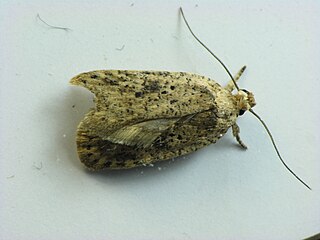| Gonioterma descitum | |
|---|---|
| Scientific classification | |
| Kingdom: | |
| Phylum: | |
| Class: | |
| Order: | |
| Family: | |
| Genus: | |
| Species: | G. descitum |
| Binomial name | |
| Gonioterma descitum Walsingham, 1913 | |
Gonioterma descitum is a moth in the Depressariidae family. It was described by Lord Walsingham in 1913. It is found in Panama. [1]

Moths comprise a group of insects related to butterflies, belonging to the order Lepidoptera. Most lepidopterans are moths, and there are thought to be approximately 160,000 species of moth, many of which have yet to be described. Most species of moth are nocturnal, but there are also crepuscular and diurnal species.

Depressariidae is a family of moths. It has formerly been treated as a subfamily of Gelechiidae, but is now recognised as a separate family, comprising about 2300 species worldwide.

Thomas de Grey, 6th Baron Walsingham of Merton Hall, Norfolk was an English politician and amateur entomologist.
The wingspan is about 25 mm. The forewings are pale tawny argillaceous, with three rust-brown costal spots. One small one at one-fourth and the second, larger, at the middle. The third is largest and found at the outer fourth. From the last a slender line of scarcely separate brown spots descends to the tornus, much curved outward toward the termen. A brown shade is diffused from the flexus outward, crossing the fold, and is followed by a narrower brown shade arising before the middle of the dorsum and running obliquely backward nearly to the first costal spot. A faintly indicated similar shade curves outward from the second costal spot, but is lost before attaining the dorsum. A series of small narrow brown spots extends along the termen at the base of the pale tawny argillaceous cilia. The hindwings are yellow. [2]

The wingspan of a bird or an airplane is the distance from one wingtip to the other wingtip. For example, the Boeing 777-200 has a wingspan of 60.93 metres, and a wandering albatross caught in 1965 had a wingspan of 3.63 metres, the official record for a living bird. The term wingspan, more technically extent, is also used for other winged animals such as pterosaurs, bats, insects, etc., and other fixed-wing aircraft such as ornithopters. In humans, the term wingspan also refers to the arm span, which is distance between the length from one end of an individual's arms to the other when raised parallel to the ground at shoulder height at a 90º angle. Former professional basketball player Manute Bol stands at 7 ft 7 in (2.31 m) and owns one of the largest wingspans at 8 ft 6 in (2.59 m).